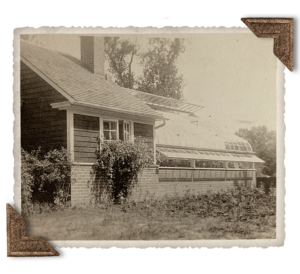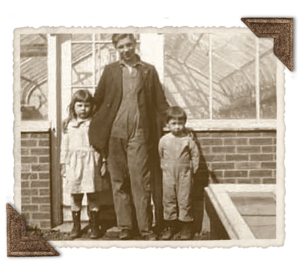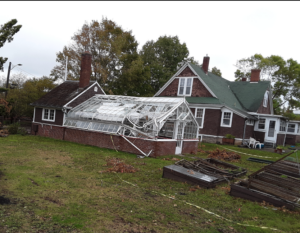The Design
 Brucemore was originally built with a conservatory (glasshouse) attached to the south façade of the mansion. When the Douglas family purchased the estate and expanded the property from 10 to 33 acres in the early 1900s, they removed the conservatory and added other buildings to support a more self-sustainable lifestyle as part of the Country Estate Movement.
Brucemore was originally built with a conservatory (glasshouse) attached to the south façade of the mansion. When the Douglas family purchased the estate and expanded the property from 10 to 33 acres in the early 1900s, they removed the conservatory and added other buildings to support a more self-sustainable lifestyle as part of the Country Estate Movement.
In 1915, they added a freestanding Lord & Burnham Greenhouse that was state-of-the-art at the time. It consisted of a headhouse, glasshouse, and unattached cold frames to allow the growth of flowers and plants for the gardens.
Lord & Burnham: The Height of 20th Century Tastes
During the heyday of the Country Estate Movement, interest in home agriculture skyrocketed and homeowners could choose from a range of both custom and stock greenhouses. The Douglases selected a mid-range model from the premier manufacturer of its time, Lord & Burnham Company.
Brucemore’s Lord & Burnham Greenhouse will return to full operation and supporting work in the gardens in the fall of 2022 following repairs to derecho damage.
Explore the Headhouse
The headhouse, which housed the Head Gardener’s office, acted as the estate’s gardening and landscaping headquarter. Inside this multipurpose space, gardeners and seasonal staff completed indoor gardening work, ordered supplies, and created plans for the garden.
The headhouse includes a basement, which offered storage space and held a boiler that provided hot water for steam to heat the glasshouse.
Explore the Glasshouse
The temperature-controlled glasshouse provided an ideal space for the gardeners to start seeds, plant vegetables, and house delicate plants during the cold season.
How it works: Sunlight enters the glasshouse during the day, warming the plants and air inside. Because the glass walls trap heat produced by the sun, the glasshouse can stay warm even when the air is cooler outside.

Additional technology, including cast iron pipes and a boiler system, allows the gardeners to further control the temperature of the glasshouse.
Explore Hot Beds & Cold Frames
Located outside the glasshouse, hot beds and cold frames provide additional options for temperature-controlled gardening. Both were used to grow cold weather plants and vegetables like lettuce and beets, protect delicate plants from freezing during the cold, and transition seedlings from the glasshouse to the garden.
How they work: Cold frames have glass lids that act as mini greenhouses, trapping heat produced by the sun while the surrounding soil provides warmth from the ground. Meanwhile, uncovered hot beds historically used decomposing manure to generate heat.

Meet the Douglas estate’s Head Gardener, Archie White
 From 1921 to 1937, the Douglases employed Archie White as the estate’s head gardener—a prestigious post that paid $200/month (compared to $97/month for seasonal laborers). His duties included maintaining the landscape around the property, removing snow in the winter, hiring other laborers, doing payroll, and managing accounts. An important member of the staff, Archie was also responsible for carrying out the family’s landscape plans when they traveled.
From 1921 to 1937, the Douglases employed Archie White as the estate’s head gardener—a prestigious post that paid $200/month (compared to $97/month for seasonal laborers). His duties included maintaining the landscape around the property, removing snow in the winter, hiring other laborers, doing payroll, and managing accounts. An important member of the staff, Archie was also responsible for carrying out the family’s landscape plans when they traveled.
Archie and his own family lived in a duplex next door to the greenhouse, allowing him to live close to his work. A notebook that he kept and is part of Brucemore’s archives today includes extensive notes and detailed hand drawings of his plans, giving us a window into what his work—and life—were like.
Preservation & Recovery Efforts
 In 2012, the Lord & Burnham Greenhouse was rehabilitated following decades of disrepair. This involved making it fully functioning and removing some of the Hall era features.
In 2012, the Lord & Burnham Greenhouse was rehabilitated following decades of disrepair. This involved making it fully functioning and removing some of the Hall era features.
Unfortunately, during the derecho, a tree fell on the glass portion of the greenhouse, which collapsed under the weight. After weeks of carefully removing trees and debris from the greenhouse’s structure, the building was assessed to understand the full extent of the damage. The frame, cast iron gutters, and shade system were all damaged.
The restoration of the greenhouse structure was completed in 2022, with pieces fabricated using original Lord & Burnham catalogues. Final steps will be taken throughout the fall of 2022 on the mechanical and electrical systems to allow it to be used once again as a fully operational space for cultivating flowers and plants for the gardens and landscape.
